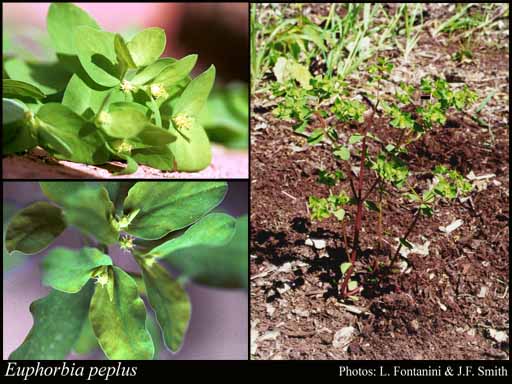- Reference
- Sp.Pl. [Linnaeus] 1:456 (1753)
- Conservation Code
- Not threatened
- Naturalised Status
- Alien to Western Australia
- Name Status
- Current
Erect or procumbent annual, herb, 0.05-0.4 m high. Fl. green-yellow, Jul to Dec or Jan. Disturbed sites.

Distribution
- IBRA Regions
- Avon Wheatbelt, Esperance Plains, Geraldton Sandplains, Jarrah Forest, Mallee, Swan Coastal Plain, Warren.
- IBRA Subregions
- Fitzgerald, Geraldton Hills, Katanning, Lesueur Sandplain, Perth, Recherche, Southern Jarrah Forest, Warren, Western Mallee.
- IMCRA Regions
- Central West Coast, Leeuwin-Naturaliste, WA South Coast.
- Local Government Areas (LGAs)
- Albany, Augusta Margaret River, Busselton, Cockburn, Cottesloe, Cranbrook, Denmark, Esperance, Fremantle, Gnowangerup, Greater Geraldton, Irwin, Manjimup, Melville, Murray, Nannup, Nedlands, Perth, Pingelly, Ravensthorpe, Rockingham, South Perth, Stirling, Swan, Victoria Park, Wanneroo.
Management Notes (for the Swan NRM Region)
Alternative Names. Radium Weed, Cancer Weed, Milkweed.
General Biology. Growth form. Herb. Life form. Annual. Reproduction. Seed. Dispersal. Ants, water, soil movement. Toxicity. Sap is poisonous and irritant.
Notes. Colonises degraded and disturbed sites. Contains natural insecticides. Seed has elaiosomes (fleshy appendages) allowing them to be dispersed by ants.
Additional information. Origin. North Africa, temperate and tropical Asia, Europe. History of use/introduction. Seed contaminant, medicines. Similar exotic species. Euphorbia terracina, E. lathyrus.
Suggested method of management and control. Spray metsulfuron methyl at 0.1 g/15 L (2.5 g/ha) + wetting agent or glyphosate at 0.5% while actively growing. Read the manufacturers' labels and material safety data sheets before using herbicides. For further information consult the Australian Pesticides and Veterinary Medicines Authority to determine the status of permits for your situation or state.
Management Calendar
| Calendar Type | Jan | Feb | Mar | Apr | May | Jun | Jul | Aug | Sep | Oct | Nov | Dec | Comments |
|---|---|---|---|---|---|---|---|---|---|---|---|---|---|
| Germination | O | Y | Y | Y | Y | Y | Y | Y | |||||
| Active Growth | O | Y | Y | Y | Y | Y | Y | Y | O | ||||
| Flowering | Y | O | O | O | O | O | O | Y | Y | Y | Y | Y | |
| Fruiting | Y | O | O | Y | Y | Y | Y | ||||||
| Herbicide Treatment | O | Y | Y | Y | Y | O | O |
Legend: Y = Yes, regularly, O = Occasionally, U = Uncertain, referred by others but not confirmed.
References
- Anon. (2002) Euphorbia peplus (Radium weed). Australian Naturopathic Network URL: http://www.ann.com.au/index.htm - Accessed April 2010.
- Brown, K. & Brooks, K. (2002) Bushland Weeds: A Practical Guide to their Management. Environmental Weeds Action Network, Greenwood.
- Gayar, F.H., Shazli, A.Y. & Abbassy, M.A. (2009) Toxicity of Euphorbia peplus L. (Euphorbiaceae) to insects. Zeitschrift für Angewandte Entomologie, 68 (1-4): 56-63.
- Hussey, B.M.J., Keighery, G.J., Dodd, J., Lloyd, S.G. & Cousens, R.D. (2007) Western Weeds. A guide to the weeds of Western Australia. 2nd Edition. The Plant Protection Society of Western Australia, Victoria Park.
- Pemberton, R.W. & Irving, D.W. (2008) Elaiosomes on weed seeds and the potential for myrmecochory in naturalized plants. Weed Science, 38 (6): 615-619.
- Shepherd, R.C.H. (2004) Pretty but Poisonous. Plants Poisonous to People. An llustrated Guide for Australia. R.G. and F.J. Richardson, Melbourne.
- USDA, ARS, National Genetic Resources Program (2009) Germplasm Resources Information Network - (GRIN). National Germplasm Resources Laboratory, Beltsville, Maryland. URL: https://npgsweb.ars-grin.gov/gringlobal/taxon/taxonomysimple.aspx - Accessed October 2009.